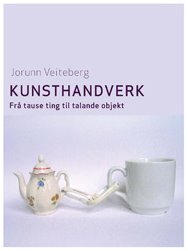
Craft in Transition is an excellent new book on craft theory by Jorunn Veiteberg of Bergen National Academy of the Arts, Norway. Recently translated and published in English, this highly readable volume is an extremely important contribution to its field. Presented in three parts, the first essay explores the shifting boundaries of craft practice, the challenges of definition, and its relationship to contemporary fine art. The second part examines "the problem of beauty" and is in itself a vital contribution. The third part explores the craft / fine art relationship through an exhibition curated by the author in Bergen. An earlier version of this essay was presented at the Gray's School of Art Challenging Craft Conference. In summary, highly readable and engaging, full of fresh insights. My personal favourite is this:
It is not what beauty is that is the issue, rather what it does. Beauty is about the rhetorical tools that craft utilises in order to arouse visual joy and desirte, heal spiritual wounds and worn out bodies, and about the aspect that makes a piece irresistable (even though we may not have liked it initially). In brief, beauty is about craft's affective side.
This looks great Mike. I will read it too. I am busy reading 'The Secret Power of Beauty' by John Armstrong."We see beauty more readily than we recognize it's causes. We are open to corrupting influences because we don't have confidence in our own responses." Aint that the truth!
ReplyDeleteWithout getting too academic, I think the term "affective" as it is used here is referring to specific type of knowledge, which defining here, I believe, has a specific relevance to the conversation on this site.
ReplyDeleteBenjamin Bloom's (1956) taxonomy identifies three distinct domains of learning as psychomotor, cognitive and affective. The term the affective in this context is defined as a domain of learning, which involves feelings, attitudes, and values; naturally, this domain is not easily measured.
I have taken these domains as originally outlined by Bloom (1956) and adapted his theory to a person’s interaction with a craft object. My purpose here is to theorize how a viewer might respond to an handmade art object and thusly develop within themselves, a value for craft through a systematic, internal process.
1. Receiving: willingness to receive the tacit or visual stimuli from the object.
2. Responding: interacting with the object, observing it's tacit or visual features (ie. surface quality, nature of its construction, the form, etc)
3. Valuing: seeing the value in the object, accepting it as a valid and valuable outcome of human creativity.
4. Organization: synthesizing a complex set of values and developing a consistent value system that is inclusive of craft within its relationship to art and design.
5. Characterization by a Value: internalization of a value for craft within an individual's hierarchy of values, relative to other outcomes or objects of material culture.
Bloom, B. (Ed.). (1956). Taxonomy of educational objectives. New York: David McKay.
Well put Dennis, and for others following this discussion check out his excellent blog - http://www.redefiningcraft.com/ - which is also linked from the "stuff we read" section of this blog's main page.
ReplyDeleteDoes anybody know where I can buy this book????
ReplyDeleteyes can anybody tell me where to buy this book? I don't seem to find it anywhere on line...Thanks!
ReplyDeleteiam also trying to buy this book any one know where you can get hold of it?
ReplyDelete